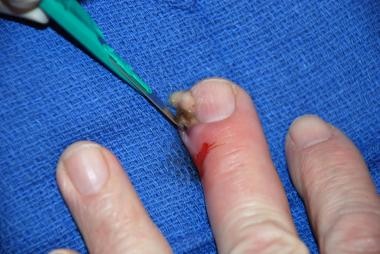What Is the Best Antibiotic for Paronychia
Treatment usually involves antibiotic medicines for germ bacterial infections. When a bacterial infection causes acute paronychia a doctor may recommend an antibiotic such as dicloxacillin or clindamycin.

Acute And Chronic Paronychia American Family Physician
The recommended treatment for mild paronychia is conservative.

. Oral antibiotics are only recommended in refractory cases or in patients with comorbidities such as diabetes or immunosuppression. Coli and most utis will respond to a short course of cipro c. When a bacterial infection causes acute paronychia a doctor may recommend an antibiotic such as dicloxacillin or clindamycin.
Combination therapy with an intravenous agent that provides antimicrobial activity against staphylococci is. Paronychia is nail inflammation that may result from trauma irritation or infection. These medications are topical and typically include clotrimazole or ketoconazole.
Most utis are due to e. Cephalexin may also be effective. It can be defined as an inflammation lasting for more than 6 weeks and involving one or more of the three nail folds one proximal and two lateral This review aims to throw a light on the current concepts in etiopathogenesis of chronic paronychia and brings in detail the past and present.
The following list of medications are in some way. Occasionally antifungal medicines for infection caused by a yeast candida or a fungus are used. Most utis are due to e.
Betel leaves contain antibacterial as well as antifungal properties. Best antibiotic depends upon the causative organism bacteria. If a fungal infection causes chronic paronychia a doctor will.
Doxycycline has been found effective for treatment of paronychia caused by antiepidermal growth factor receptor antibodies5 A case report describes successful treatment with twice-daily. Acute paronychia causes redness warmth and pain along the nail margin. See also Overview of Nail Disorders.
Paronychia can develop when bacteria enter broken skin near the cuticle and nail fold causing an infection. It can affect fingernails or toenails. The cuticle is the skin at the base of the nail.
Is azithromycin a good antibiotic to take for paronychia Paronychia what is the antibiotic most often used for treatment Connect with a US. The main difference between these ointments is that they have different ingredients. An antistaphylococcal penicillin or first-generation cephalosporin is generally effective.
Diagnosis is by inspection. Wider spread infections of this nature may require oral antibiotics such as clindamycin or amoxicillin to kill them. Soak the affected foot or hand 3 to 4 times daily for 20 minutes inantiseptic solution of warm water and chlorhexadine or povidone-iodine.
Betel leaves are one of the oldest remedies for paronychia. A healthcare professional may need to be involved in your acute paronychia treatment if an abscess forms or if the infection spreads to other parts of your finger or toe beyond the nailbed. Cipro ciprofloxacin and Bactrim.
The bottom line. Clindamycin and amoxicillin-clavulanate are also appropriate. When a fungal infection causes chronic paronychia a doctor will prescribe antifungal medication.
If an abscess has formed around the nail incision and drainage is added. Topical antibiotics used may be a triple antibiotic ointment bacitracin or mupirocin. To use betel leaves collect a few leaves and then crush them to make a paste.
22 rows Drugs used to treat Paronychia. 30 rows The combination of topical antibiotic and corticosteroid such as. Chronic paronychia is an inflammatory recalcitrant disorder affecting the nail folds.
Overview of Nail Disorders A variety of disorders can affect nails including. Dicloxacillin 250mg four times a day or cephalexin 500mg three to four times a day. Paronychia is infection of the periungual tissues.
Treatment is with antistaphylococcal antibiotics and drainage of any pus. Polysporin Neosporin and bacitracin are all OTC antibiotic ointments that you can use to help treat or prevent infection for minor cuts or scrapes. In some cases steroid creams may be needed for the skin around the nail.
Now apply this paste to the affected nail and then cover it. Antibiotics like Bacitracin are recommended to apply on-site but an individual with paronychia under treatment needs to follow up with doctor within 24 48 hours to get assured whether the infection is healing or not. Paronychia is a common infection of the skin just next to a nail.
But all of them contain bacitracin and two of them contain polymyxin B. Warm compresses or soaks are used along with topical antibiotics with or without topical steroids. Chronic paronychia Since most cases of chronic paronychia are caused by fungi your doctor will treat the infection with antifungal medication that is applied to the skin such as clotrimazole Lotrimin Mycelex or ketoconazole.
In patients failing topical treatment or more severe cases oral antibiotics are an option. Normally antibiotics are not given to the patients until an extensive level of infection is not found. You may have to apply the medicine every day for several weeks.
The nail fold is where the skin and nail come together.

Acute And Chronic Paronychia American Family Physician

Acute And Chronic Paronychia American Family Physician

Acute And Chronic Paronychia American Family Physician

Paronychia Treatment Management Approach Considerations Pharmacologic And Other Noninvasive Treatment Drainage
No comments for "What Is the Best Antibiotic for Paronychia"
Post a Comment